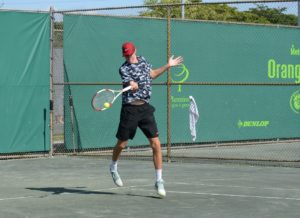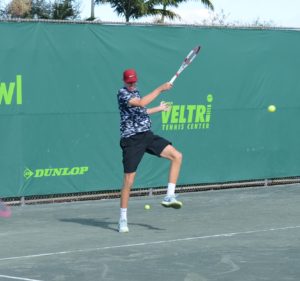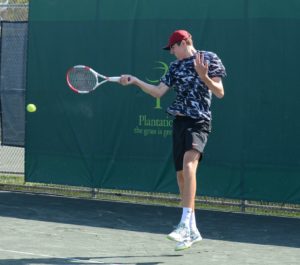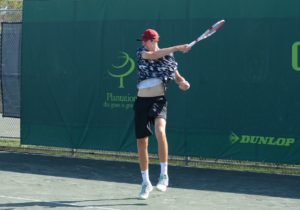Reilly Opelka – Rather troubled forehand

Since quite a few years already, really tall Reilly Opelka (*97 / USA) looked with his 6’11” (211 cm) like the potential replacement of the slowly declining aging giant Ivo Karlovic (CRO) who is observing the world and the tennis courts from about the same height like Reilly himself. When I saw Reilly at the 2014 Orange Bowl over 3 years ago, I have expected him to become quite a serious pro tour contender in the following 2-3 years. While seeing his qualification match at the 2017 French Open (epic 3-set win against Daniel Munoz-de la Nava – ESP), I was rather negatively surprised by the state of his game development. It is surely difficult to state a clear opinion about a player after seeing just a part of one match, but there were clear signs, which showed to an experienced coach, that Reilley’s development was rather a bit troubled as both his service and his forehand seemed to have in many cases rather less body energy integration (less of the efficient body energy unloading) than it was the case in the end of 2014.
Below, I am comparing Reilley’s forehands at these two above mentioned events, all photos are from his serving games. I am surely aware that the coordination and an exact footwork are challenging at Reilly’s size, but what I am focusing at is the way how he approaches the given strokes as this gives me certain information about the mental image of the stroke in his mind. In the case of an optimal “3 Step Tennis Stroke Regulation”, the player puts the priority at the creation of the sufficient space for the stroke, which will make a long elbow motion away from the center of the gravity in the form of a long axis pronation combined with an optimal rotation-based body energy unloading into the stroke possible. In the case of the focus on the hitting arm activity, however, the body energy unloading mostly stays to a big degree behind… Very tall and thus rather weaker movers like Karlovic or Isner put big focus on the creation of the space for the forehands, which they “have to play”, mainly in their serving games. Even they can’t make it every time, but the proper mental image of the intended stroke/action increases the percentage of the strokes played with the optimal “3 Step Tennis Stroke Regulation”, which is making the body energy dominance of the strokes possible. Comparing Reilly’s forehand from 2014 and 2017, I am having the feeling that the mental image of his forehand might have changed, rather not for a better one….

Reilly Opelka (*1997 / USA) – Forehand 3.0 in a serving game of a match – 1 of 2 – impact – quite in front of the body with an excellent eye control of the impact zone, push-off with the outside/right leg started the body rotation – 2014 Orange Bowl – Plantation, FL / USA

Reilly Opelka (*1997 / USA) – Forehand 3.0 in a serving game of a match – 2 of 2 – end of follow through 1 with a well-controlled targeted pronation and a very solid unloading of the body energy – the axis of the rotation is inside of the body – 2014 Orange Bowl – Plantation, FL / USA

Reilly Opelka (*1997 / USA) – Forehand 3.0 in a serving game of a match – 1 of 2 – early follow through 1 with a well-controlled targeted pronation and elbow pointing to the front, solid body balance and body rotation leading to certain body energy unloading while fighting for a position close to the baseline – 2014 Orange Bowl – Plantation, FL / USA

Reilly Opelka (*1997 / USA) – Forehand 3.0 in a serving game of a match – 2 of 2 – follow through 2 = relaxation with a good body energy and balance control – 2014 Orange Bowl – Plantation, FL / USA

Reilly Opelka (*1997 / USA) – Forehand in a match – 1 of 2 – short after the impact – excellent body and eye control, the body energy unloading is partly reduced due to limited space – 2014 Orange Bowl – Plantation, FL / USA

Reilly Opelka (*1997 / USA) – Forehand in a match – 2 of 2 – end of follow through 1 – well-controlled body rotation, elbow is rather too close to the body too early, but certain body energy unloading was still possible – 2014 Orange Bowl – Plantation, FL / USA

Reilly Opelka (*97 / USA) – Forehand as the 3rd stroke in a serving game of a match – 1 of 2 – backswing – position of the feet and body doesn’t give the feeling of an optimal space creation and loading – 2017 French Open Qualification – Paris / France – May 2017

Reilly Opelka (*97 / USA) – Forehand as the 3rd stroke in the serving game of a match – 2 of 2 – early follow through – center of gravity goes back – this stroke is dominated by the arm action, body energy unloading is almost not present – 2017 French Open Qualification – Paris / France – May 2017

Reilly Opelka (*97 / USA) – Forehand in a serving game of a match – 1 of 2 – impact of a stroke played in a direct stance – body loading and space creation are very limited – 2017 French Open Qualification – Paris / France – May 2017

Reilly Opelka (*97 / USA) – Forehand in serving game of a match – 2 of 2 – end of follow through 1 – pronation is happening just from the forearm action, body energy unloading was mostly missing – 2017 French Open Qualification – Paris / France – May 2017

Reilly Opelka (*97 / USA) – Forehand as the 3rd stroke in a serving game of match – 1 of 2 – impact with a good eye control – limited space – 2017 French Open Qualification – Paris / France – May 2017

Reilly Opelka (*97 / USA) – Forehand as the 3rd stroke in a serving game of a match – 2 of 2 – end of follow through 1 – pronation is dominated by the forearm action, center of gravity went slightly back – the entire stroke is dominated by the activity of the arm, effect of the body energy unloading is very limited – 2017 French Open Qualification – Paris / France – May 2017

Reilly Opelka (*97 / USA) – Forehand in a serving game of a match – 1 of 3 – short after the impact – good racket control, but the positions of the reference points on the hip, shoulder as well as on the elbow show that the stroke is dominated mainly by the activity of the arm – 2017 French Open Qualification – Paris / France – May 2017

Reilly Opelka (*97 / USA) – Forehand in a serving game of a match – 2 of 3 – end of follow through 1 – as the prepared space was very limited elbow stayed jammed close to the body – 2017 French Open Qualification – Paris / France – May 2017

Reilly Opelka (*97 / USA) – Forehand in a serving game of a match – 3 of 3 – follow through 2 = relaxation – late body rotation had practically no effect at the striking of the ball – 2017 French Open Qualification – Paris / France – May 2017
This article covers certain aspects of Reilly Opelka’s forehand and forehand in general only! Further photos, more details about his forehand and other strokes as well as about the strokes of other players are available upon request at drmgb11(at)gmail.com. Some significant details of this kind, necessary for a top tennis performance as well as for a sustainable tennis training/development in general, are being discussed also in the seminar “TENNIS 3.0 – Future of the Game”, which is available worldwide upon request – www.tennis30.com / www.tennis30.cz
Photos (December 2014 & May 2017) & text (January 2018) copyright by Dr. Martin G. Baroch. Any further publication of either any of the photos and/or texts with the explicit written permission from the author/copyright owner only!!



